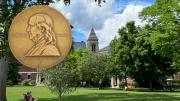Following up on promises made four years ago, and as critical issues regarding environmental sustainability and climate change take center stage during this election year, President Drew Faust has announced the release of Harvard’s first University-wide Sustainability Impact Report—an interactive website filled with data on the University’s efforts to make the campus environmentally friendly.
The goal of the report, according to the website, is to “Provide a baseline for future reporting and benchmarking by collecting and displaying sustainability performance data across our University; display the breadth and depth of our community’s commitment to sustainability in order to educate and hopefully inspire others inside and outside Harvard; and to encourage an open and honest conversation about the challenges we face in implementing Harvard’s sustainability goals so we can identify the solutions that will help us move forward.”
The “metrics” section of the website includes interactive charts and graphs that present a variety of data, including information on energy and emissions, transportation, health and wellness, water, green buildings, waste reduction, and recycling. According to the “Our Vision” section, the University is following three specific commitments to sustainability:
- Greenhouse Gas (GHG) Reduction Goal to reduce GHG emissions 30 percent below a 2006 baseline by 2016, including growth (adopted in 2008).
- Comprehensive Green Building Standards for capital projects, renovations, and building-system upgrades $100,000 and above. (Adopted 2009, building on the 2007 Green Building Guidelines that applied to projects of $5 million and above).
- Campus-wide Sustainability Principles that provide a broad vision to guide University operations and planning (adopted in 2004).
Harvard first announced its efforts to address challenges of environmental sustainability and climate change four years ago at an event attended by 15,000 people in Tercentenary Theatre. The “Our Journey” section of the website offers a timeline that lets users scroll through and see photographs and facts highlighting the University’s journey towards a green campus.
“Sustainability at Harvard is about more than recycling and turning off lights. It’s about shifting the culture of an institution and inspiring the next generation of environmental leaders,” the “Our Journey” section states. “Integrating sustainability into the culture of how Harvard works and lives has been a journey that began decades ago inspired by students and then driven by staff and faculty partnerships dedicated to addressing the global challenges of climate change and environmental sustainability.”









